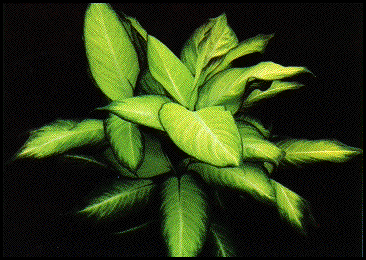Dieffenbachia 'Triumph'Return to: MREC Home Page A Hybrid Dieffenbachia for Foliage ProducersR.J. Henny, Associate Professor and
Geneticist University of Florida, Mature plant of
Dieffenbachia 'Triumph' IntroductionDieffenbachia species and cultivars are important tropical ornamental foliage plants because of their attractive foliar variegation, ease of production, and adaptability to interior environments. Approximately 20 cultivars have been produced commercially in Florida. Previously, most new cultivars were obtained from private plant collections or as mutations of established cultivars. Because dieffenbachia occur naturally in a variety of sizes, growth habits, and variegation patterns, they were included as part of the foliage plant breeding program at the Agricultural Research and Education Center-Apopka. The hybrid Dieffenbachia cultivar 'Triumph' was developed and selected as part of that program. Origin and DescriptionFour crosses involving seven different parent plants were included in developing Triumph (Figure 1) pedigree of D. Triumph Triumph is similar in size to D. 'Perfection' and possesses the foliar variegation of D. 'Camille' combined with a white midrib from D. 'Wilson's Delight'. Leaves are held by short clasping petioles to give a compact growth habit. Triumph has multicolored petioles consisting of two russet-colored outer bands which blend into pink inner bands that surround a white central core. The coloration intensifies as the petiole matures. Performance Growth characteristics of Triumph were determined during 1984 and 1985 in replicated greenhouse trials. Two trials were conducted utilizing tissue culture liners rooted in 2.5-cm cell trays and potted into 15-cm pots containing Vergro container mix, and one trial utilized 15-cm tip cuttings rooted directly in 15-cm pots of the above mix. Dates of these trials were April 18, 1984 to August 13, 1984 (Trial I; cuttings); March 15, 1985 to August 29, 1985 (Trial II; Tissue culture liners); and May 20, 1985 to September 26, 1985 (Trial III; Tissue culture liners). Plants from Trials I and II were grown under two shade levels of 1000 and 2000 ft-c light intensities maximum and supplied three fertility levels; 750, 1500, and 2250 lbs nitrogen/acre/year (N/A/yr) equivalent. Plants in Trial III received the same light levels, but fertilizer levels were 750, 1500, 2250, 3000 and 3750 lbs N/A/yr. Growth rate of Triumph was excellent with 10 to 15-cm tip cuttings reaching marketable size in 15-cm pots in 4 months or less and tissue culture liners taking 4 to 6 months depending on season. Increasing light intensity from 1000 to 2000 ft-c maximum slightly reduced height in one trial out of three, and leaf length and width in Trials I and II. (Table 1.) Light intensity had no effect on number of basal shoots, but plants from cuttings (Trial I) had less than half the number of shoots found on liners from tissue-culture. Color grade was improved under the lower light intensity, but overall plant grade was not improved. (Table 2.) Higher light also slightly increased number of chlorotic leaves in one trial. Table 1: Evaluation of light intensity and fertilizer rate on growth quality of `Triumph'.
z ns = not significant; L = linear; Q = quadratic; C = cubic; * = significant at 5% level and ** = significant at 1% level. Increased fertilizer rates slightly increased height in Trial I, but had no effect in Trial II and decreased height in Trial III. (Table 1.) Leaf length and width were larger in plants from cuttings, but this was probably a result of fewer basal shoots. Leaf length and width were quadratic in Trial I, and decreased with increasing fertilizer in Trial III. Effect of fertilizer rate was variable on number of shoots produced, (Table 1.) with greatest number occurring between 1500 and 2250 lb N/A/yr. Although color grade increased in Trial I with increasing fertilizer rate, there was no effect in the other trials. (Table 2.) Plant grade increased in Trial I with increased fertilizer but was not affected in Trial II and was reduced at the two highest levels in Trial III. A greater number of chlorotic older leaves was associated with higher light levels, and generally increased with higher fertilizer levels. Table 2: Evaluation of light intensity & fertilizer rate on growth of Triumph.
z 1 = poor, chlorotic; 3 =
good, medium green and 5 = excellent, dark green and
yellov contrast. Plants from Trial I were held under an interior environment for 90 days. Triumph maintained excellent quality and slightly increased plant grade indoors. (Table 3.) Color grade continued to be best on plants grown under the lower light intensity. Plant grade was best when the median fertilizer level (1500 lb N/A/yr) was used in production, while plants receiving the highest levels had best color grade. Table 3. Postharvest quality of
Triumph held 90 days under 100 ft-c/12 hrs/day.
z 1 = poor, chlorotic; 3 =
good, medium green and 5 = excellent, dark green and
yellow contrast RecommendationsTriumph is intended for commercial foliage producers growing finished plants in 15-cm containers. This new cultivar is also attractive in 10-cm pots. Best growth can be expected when plants are grown with a light intensity of 1000 to 1500 ft-c when receiving 1500 lb N/A/yr from a 3-1-2 ratio (N, P205, K20) fertilizer. Plants should not be stressed with excess fertilizer (above 1800 lb N/A/yr) or slight edge chlorosis may be induced on older leaves. The branching habit of this cultivar is better when it is grown from tissue culture plantlets. Plants grown from cuttings have a more open appearance and a lower number of shoots with some shoots arising from lower nodes above ground level. Under excessive levels of fertilization, some reduction in the pink coloration of the petioles will also be noted. AvailabilityTriumph has been trademarked and released to Florida tissue culture labs for propagation and distribution. Inquiries regarding participating labs may be obtained by writing the Florida Foundation Seed Producers, Inc., P.O. Box 309, Greenwood, FL 32443. [Revised - 2/28/97] |
|||||||||||||||||||||||||||||||||||||||||||||||||||||||||||||||||||||||||||||||||||||||||||||||||||||||||||||||||||||||||||||||||||||||||||||||||||||||||||||||||||||||||||||||||||||||||||||||||||||||||||||||||||||||||||||||||||||||||||||||||||||||||||||||||||||||||||||||||||||||||||||||||||||||||||||||||||||||||||||||||
